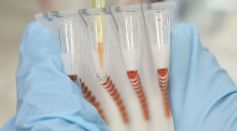Tags: Cell
NIH Funds $125M for Tissue Mapping Centers for Cellular Senescence to Study Lymphoid Organs

Henrietta Lacks Whose Stolen Cells Were Used to Test Effects of Radiation, Other Scientific Breakthroughs Receives Posthumous Award
Early Cancer Detection: Study Shows How An ‘Innovative Microscope Slide’ Can Effectively Determine Diseased Cells

NHS Approves First Ever Sickle Cell Disease Treatment After 20 Years; What Makes Crizanlizumab a Game Changer?
Hair Cell Regeneration in Humans Might Be Possible Using Lab-Grown Cochlear Organoids, New Research Found
Multipurpose Mini CRISPR System Easier to Deliver Into Human Cells for Gene Therapy, Treat Rheumatoid Arthritis, Diverse Ailments
KNUCKLES’ Role in Flower Clock; This Tiny Multi-Functional Protein Helps Complete Floral Development Properly at the Right Time
Mammalian Retrovirus-Like Protein: This May Help Expand mRNA delivery; Potential Solution for Nucleic Acid Therapies
Cells Discovered in Corals, Sea Anemones, Engulfing Bacteria; A Discovery Potential for Better Marine Health Assessment

Mini Human Brains Grown in Petri Dish Develop Own Eyes That Detect Light, Possible Solution for Vision Loss
Protein Associated with Parkinson's Disease Can Cause Damage to Cellular Powerhouses; Researchers Investigate the Contribution of Alpha-Synuclein to the Problem

Can CRISPR Switch Gene Controls Without Touching DNA? Here's What Experts Say
Scientists Color Coded Brain Cells Linked to Aging to Search for Clues on Factors Causing Memory Loss
A Unique Tool for Live-Cell Imaging
Synthesizing Chemical-Sensing Cells from Scratch
Most Popular

Starlink Satellite Explodes in Orbit; SpaceX Confirms It'll Re-Enter Earth

Aurora Phenomenon: How Geomagnetic Storms and Space Weather Are Lighting Up the World

Ocean Warming Explained: Why Climate Science Shows Sea Temperature Rise Is Speeding Up

How Wildfires Start, Spread, and Ignite: Understanding the Causes and Fire Behavior Clearly





